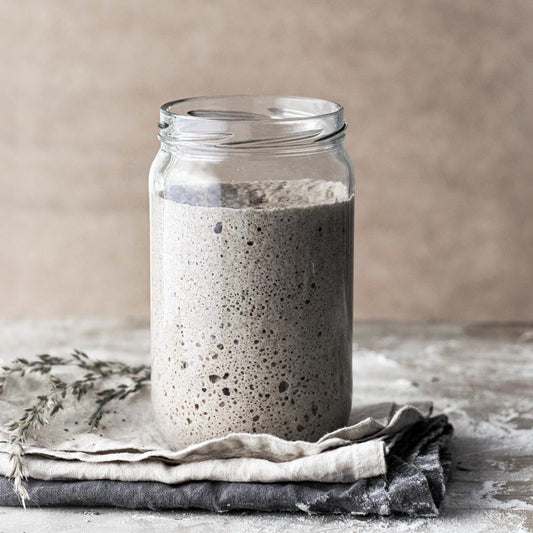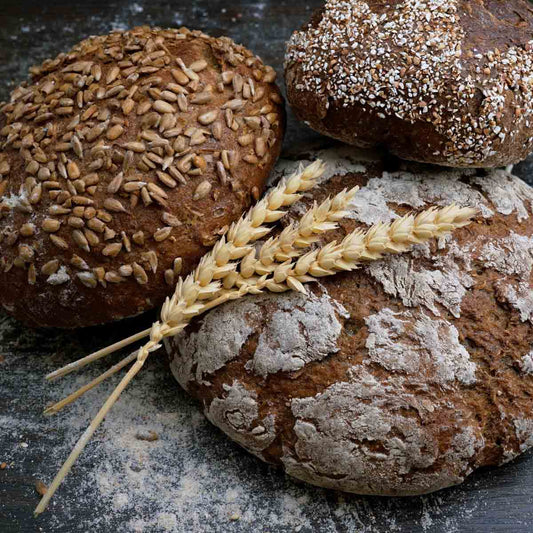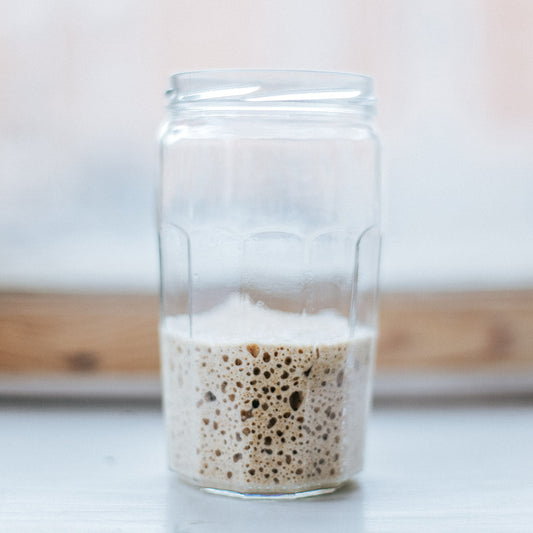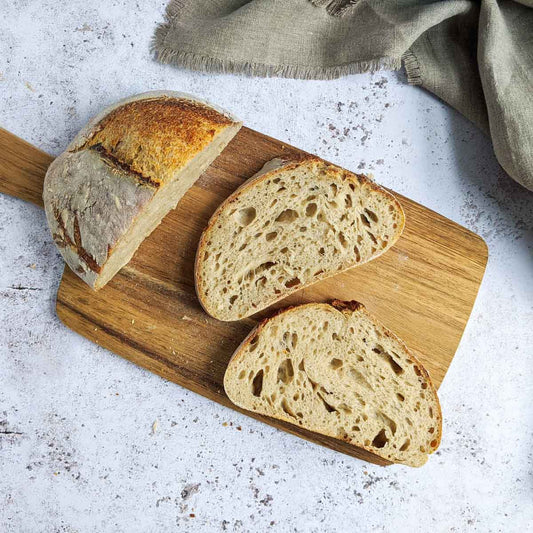What Is Sourdough Starter?
What is Sourdough Starter made of?
A sourdough starter is a fermented mixture of flour and water home to a living culture of wild yeasts and lactic acid bacteria. This bubbly, fragrant, highly active culture is a simple combination of flour and water – nothing else. But when these two ingredients are combined and given sufficient time, an incredible event takes place: wild fermentation.
Yeasts feed on sugars in flour and release carbon dioxide, which gets trapped by gluten bonds. In turn, the trapped CO2 causes the dough to rise. The lactic acid bacteria feed on sugars and proteins, converting them into lactic acid, lowering the pH, and acidifying the dough. This gives sourdough bread its classic tang and contributes to the alluring, chewy texture.
Sourdough starter is to sourdough bread what a SCOBY is to kombucha, or a kefir grain is to kefir. It’s the inoculant that initiates a wild fermentation process when added to a ball of dough. No matter how many loaves of bread it creates, a portion of the sourdough starter is always reserved. It’s kept alive and used again and again.
History of Sourdough Starter
This technique, referred to as back-slopping, is how bread has been made for at least the last 6,000 years. The oldest sourdough bread ever discovered dates back to around 3,700 B.C. But recently, researchers found an even older piece of non-leavened bread from 14,500 years ago. So if I had to guess, I’d say that sourdough fermentation originated somewhere between those two dates – it’s pretty old technology.
What is the Point of Sourdough Starter?
Sourdough starter separates sourdough bread from all other forms of modern “bread” that exist today. The stable colony of wild yeasts and lactic acid bacteria in starter initiate a transformation that turns a lifeless, deflated ball of dough into a delicious, leavened miracle. These microorganisms also pre-digest the flour, which increases the bioavailability of vitamins and minerals, breaks down complex starches and proteins, and makes grains easier to digest and more nourishing. More flavor. More nutrition. It’s a magical thing.
A Symbiotic Community
Where do the yeasts and lactic acid bacteria in sourdough starter come from? Everywhere, kind of. These microbes are indigenous to grains, and they lie dormant until exposed to water. They also exist in the air, on our hands, on the wooden spoon you might use to stir your starter. Wherever they come from, native yeasts and lactic acid bacteria begin to coexist in near-perfect harmony with each other.
Yeasts contain enzymes that break down complex starches into simple sugars that both yeasts and bacteria can consume. As they feed on those sugars, yeasts produce ethanol, a simple form of alcohol, as a by-product. Alcohol is not a super hospitable medium for most microorganisms to exist in, but lactic acid bacteria tolerate it well. At the same time, lactic acid bacteria produce consume sugars and produce lactic acid, which significantly lowers the pH of starter to around 3.5. Not a lot of life thrives in a highly acidic environment like that. But yeasts love it! This is why sourdough starters, if well maintained, don’t spoil. The yeasts and lactic acid bacteria out-compete other life forms, including pathogens and spoilage bacteria.
How is Sourdough Starter Different from Baker’s Yeast?
Baker’s Yeast came onto the scene in the late 1800s when scientists discovered how to isolate single yeast strains. This discovery offered bread manufacturers serious advantages in terms of efficiency and scale. This commercial form of isolated yeast quickly became the primary leaven for bread making. Since then, an enormous amount of time and research has gone into developing commercial yeasts that perform well in large-scale production.
Why is sourdough better than commercial yeast?
Baker’s Yeast, unlike sourdough starter, relies on a single species of yeast, Saccharomyces cerevisiae. It allows bakers to make bread that rises quickly and predictably. On the other hand, Sourdough starter contains many different strains of yeast. It also contains lactic acid bacteria, which outnumber yeasts by about one hundred to one. Because of this microbial diversity, making bread with sourdough starter is slow and time-consuming, highly unpredictable, sensitive to temperature, humidity, altitude, and the infinite variables introduced by microorganisms. It’s the antithesis of consistency and uniformity.
Despite its numerous advantages, replacing sourdough starter with Baker’s Yeast comes with enormous costs. The primary health-giving properties of sourdough bread exist because of the work carried out by lactic acid bacteria (LAB) -- the microbes that are omitted from conventional bread making. LAB are responsible for improving the nutrition and digestibility of grains. It’s their acidity that lowers the pH of the dough, a critical step that activates enzymes to break down antinutrients and release vitamins and minerals present in grains. LAB also degrade complex starches and proteins, enhancing their digestibility making it easier for your body to digest grains. Last but certainly not least, the LAB contribute flavor and texture to bread – the two things that make people so much about real sourdough. We sacrifice taste, quality, and health by forgoing this natural process in favor of efficiency and predictability.




